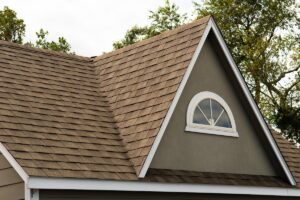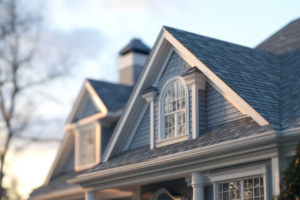It’s no secret that leaky roofs can cause all sorts of problems. But did you know that one of those problems could be mold? In fact, one of the main questions we get consistently is “can leaky roofs cause mold?” With that said, if you’re dealing with a leaky roof, it’s important to be aware of the potential for mold and take steps to prevent it. Here’s what you need to know about leaks, mold, and your roof. Without further adieau let’s get started!
What is a Leaky Roof?
A leaky roof is one that has gaps, cracks, or other imperfections in the roofing material. This can be caused by age, wear and tear, bad installation, or damage from storms. The result is water entering the home through the roof, which can lead to all sorts of problems including mold in the home.
What is Mold?
Mold is a type of fungus that grows in damp, dark places. It can range from harmless to dangerous and can cause serious health issues if left unchecked. Mold is attracted to moisture, and when there’s a leaky roof, it has an ideal breeding ground for growing.
Can Leaky Roofs Cause Mold?
Yes it can. If your roof is leaking, you may think that it is simply an inconvenience, but it can actually lead to much bigger issues in your home. Along with mold, a leaky roof can also cause structural damage and wallpaper to come loose from the walls. Not only can this mean thousands of dollars spent on repairs or replacements, it can also cause health issues for your family by having mold spores floating around inside the home. When left untreated for too long, a leaky roof can create a vicious cycle of mildew and other harmful microorganisms that spread through your entire house. If you’re dealing with a leaky roof, don’t put off making repairs. Acting quickly can help save you a lot of money and hassle in the long run.
How to Determine if Your Leaky Roof is Starting to Mold?
Figuring out whether your leaky roof is causing mold problems can be tricky since most of the signs are invisible to the naked eye. If you suspect your roof has been leaking for some time, there are a few things you can do to look for mold growth. First, take a look at any nearby walls and ceilings for any dark spots or discoloration. Check around windows, doors, and other openings where water may seep in from the roof. Even if the area looks clean, it’s still essential to explore further by feeling around for any wet spots or material that feels spongy. If you happen to notice an odd smell or musty odor while searching your home, it’s a good indication that mold is present due to moisture coming from the roof. In order to confirm that your leaky roof is causing mold growth, we strongly recommend bringing in a professional who will be able to thoroughly examine your space and provide the best course of action.
How can Mold on a Leaky Roof Impact Your Health?
If you have a leaky roof and don’t get it fixed in a timely manner, it can lead to serious health consequences. Mold is one of the most common problems to come from a leaky roof, and can be potentially dangerous if not handled properly. Exposure to airborne mold spores can cause breathing problems such as wheezing or asthma, sore throat, headaches, puffy eyes, runny nose, and even more serious diseases like cancer. The only way to guarantee avoiding these potential consequences is by fixing the roof leak promptly. Don’t let a little bit of extra work get in the way of your family’s health—take action now!
How Can You Fix a Leaky Roof that has Started to Mold?
Fixing a leaky roof that has started to mold can be tricky, but it can be done. The first thing to do is identify where the leak is coming from, which can be difficult if you don’t know what to look for. If you find the cause of the leak, it’s important to not only fix the actual hole in the roof, but also make sure there are no other areas prone to leaks, as these could become problematic down the line. You should then dry out any mold that may have built up and also ensure there is proper ventilation in the attic space. Finally, once everything has been fixed and dried out properly, consider installing a good quality waterproof sealant on both sides of the roof. With this last step you should be free from water and mold damage for quite some time.
How Can You Prevent Mold from Growing on Your Roof in the Future?
The best way to prevent mold from growing on your roof is to keep it properly maintained. This includes having regular inspections performed, and making sure that any potential leaks are fixed right away. It’s also essential to ensure proper ventilation in the attic space so that moisture doesn’t build up. If you live in an area with a lot of rain or snow, it’s important to make sure the roof is clear of debris and that there are no clogged gutters or drains. Finally, consider installing a waterproof sealant on both sides of your roof to further protect against water damage and mold growth. With these simple steps, you can rest assured that your home will stay safe and dry for years to come.
When Should You Reach out to a Professional Roofer to Assist you with Your Molded and Leaky Roof?
No roof is invincible, and all roofs need routine maintenance, especially those exposed to harsh weather conditions like hail storms, heavy snowfall and long periods of intense sunshine. When it comes to mold growth or leaking roofs, it’s best to call a professional roofer as soon as possible. An experienced roofer can determine the cause of the mold or leak – whether from worn-out parts, weak installations or a combination of both – and provide solutions that keep your roof functioning its best. A professional roofer can also make recommendations for preventative maintenance in order to avoid further damage or deterioration in the future which can save you stress and money down the line. So don’t hesitate – when your roof starts showing signs of mold growth or leaking, contact a professional right away!
Conclusion – Can Leaky Roofs Cause Mold?
All in all, if you think you have a mold problem, it’s best to contact a professional right away. Mold can be dangerous to your health, so it’s important to get it taken care of as soon as possible. In the meantime, try to keep the roofing area where the mold is growing as dry as possible. At Army Roofing we offer free quotes for our roofing services, so don’t hesitate to contact us today if you think you might need our help. You can also checkout our Google My Business here.
Areas we service include:
- Ladner Roofing
- Roofing Surrey
- Roofing Vancouver
- Roofing North Vancouver
- Roofing Tsawwassen





